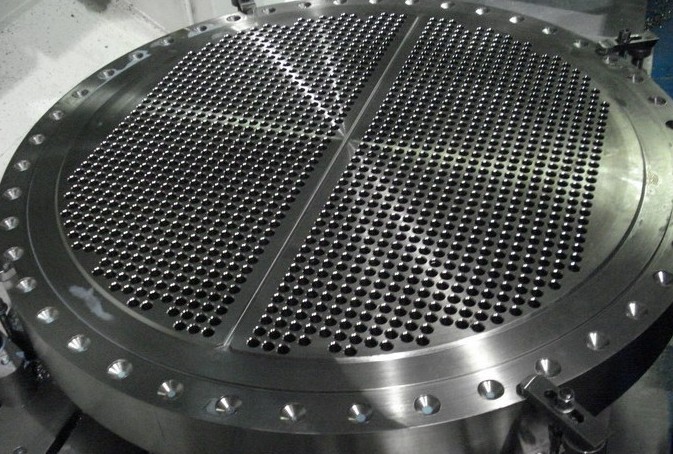Lord Fin Tube-Stainless steel tube plate flange
What is a Stainless Steel Tube Plate Flange?
A stainless steel tube plate flange is a specialized component used primarily in heat exchangers, pressure vessels, and boilers. It functions as a support structure that holds tubes in place while creating a barrier between different fluid streams.

Stainless steel tube plate flange in industrial application
The manufacturing process involves drilling holes slightly larger than the outer diameter of tubes into a stainless steel plate. The tubes are then inserted through these holes and welded in place to create a secure, leak-proof connection.
Design Considerations
Engineers must calculate the pull-off force between heat exchange tubes and the tube sheet under various operating conditions with temperature differentials. Additionally, axial stresses of the shell, heat exchange tubes, and the pull-off force must be computed to ensure structural integrity.
When performing strength checks on fixed tube sheets, expansion joints often become necessary. In cases where the tube sheet thickness is insufficient without expansion joints, adding these components can resolve the issue while potentially reducing material consumption and manufacturing complexity.
U-Shaped Expansion Joints
U-shaped expansion joints are frequently implemented in fixed tube sheet heat exchangers due to their compact design, effective compensation capabilities, and cost-effectiveness. These components accommodate thermal expansion and contraction, preventing stress buildup that could compromise the system.
Applications of Stainless Steel Tube Plate Flanges
Stainless steel tube plate flanges serve critical functions across multiple industries:
Heat Exchangers
Provide structural support for tubes while separating fluid streams in shell and tube heat exchangers.
Boilers & Pressure Vessels
Create secure tube connections in high-pressure and high-temperature environments.
Chemical Processing
Withstand corrosive environments while maintaining structural integrity in reactors and condensers.
Power Generation
Used in condensers, evaporators, and other thermal management systems in power plants.
The exceptional strength, rigidity, and thermal conductivity of stainless steel make it an ideal material for these demanding applications. As chemical and power plants continue to scale up, tube sheet diameters have increased accordingly, with 4 to 5 meter diameter tube sheets now common in industrial applications.
Quality Standards for Stainless Steel Tube Plate Flanges
Precision manufacturing is critical for tube sheet performance. Key quality indicators include:
- Hole Position Accuracy: Precise placement ensures proper tube alignment and fit
- Aperture Tolerance: Consistent hole diameters prevent leakage and stress points
- Surface Smoothness: Minimizes turbulence and pressure drop in fluid systems
- Burr Elimination: Prevents damage to tubes during installation
- Slotting Position Accuracy: Critical for complex multi-pass configurations
For double tube sheet applications, hole position accuracy becomes even more critical. Modern CNC drilling machines typically ensure these tolerances, though larger diameter thick plates (over 300mm) present additional challenges requiring specialized equipment.
| Quality Parameter | Standard Tolerance | Precision Grade |
|---|---|---|
| Hole Diameter | ±0.1 mm | ±0.05 mm |
| Hole Position | ±0.2 mm | ±0.1 mm |
| Surface Finish | Ra 3.2 μm | Ra 1.6 μm |
| Perpendicularity | 0.1 mm/100 mm | 0.05 mm/100 mm |
Advanced Manufacturing Techniques
Traditional tube sheet manufacturing relied heavily on radial drilling machines with manual operation. While methods like drilling jigs improved efficiency, they couldnt address fundamental limitations in precision and scalability.
CNC Technology Revolution
Multi-axis CNC drilling machines have transformed tube sheet manufacturing by replacing manual processes with automated precision. These systems eliminate manual scribing and drilling, significantly improving accuracy and throughput.
Equipment Challenges
While CNC technology has advanced globally, limitations remain in domestic manufacturing capabilities for large tube sheets (exceeding 7 meters). Imported CNC machines offer solutions but come with high costs, lengthy installation periods, and maintenance challenges. Theres growing demand for domestic manufacturers to develop ultra-large CNC drilling machines tailored to local industry needs.
Future Trends
The adoption of specialized gantry machining centers continues to grow, particularly for large-diameter thick plates requiring sophisticated tooling. These advanced systems enable manufacturers to meet increasingly stringent precision requirements while improving production efficiency.
Material Selection Considerations
Choosing the appropriate stainless steel grade for tube plate flanges depends on several factors:
- Corrosion Resistance: Match material to the specific chemical environment
- Temperature Requirements: Consider thermal expansion and strength at operating temperatures
- Pressure Conditions: Ensure material strength meets design pressure specifications
- Fabrication Requirements: Consider weldability and machinability during manufacturing
- Lifecycle Costs: Balance initial material costs against maintenance and replacement expenses
Common stainless steel grades for tube plate applications include 304, 304L, 316, 316L, 321, and 347, each offering specific advantages for different operating conditions.
Installation and Maintenance Best Practices
Proper installation and maintenance are crucial for optimal performance and longevity of stainless steel tube plate flanges:
Installation
- Ensure proper alignment before welding to prevent stress concentrations
- Use appropriate welding procedures and filler materials
- Implement proper heat treatment when required
- Conduct thorough inspection post-installation
Maintenance Protocols
- Regular visual inspection for signs of corrosion or damage
- Periodic non-destructive testing for internal defects
- Monitoring for leakage at tube-to-tubesheet joints
- Documentation of all maintenance activities

